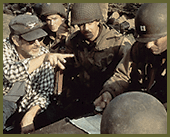Why did you choose to shoot Private Ryan in the 1.85:1 format rather than a widescreen format?
Spielberg: To me, widescreen formats like CinemaScope were a Hollywood invention of the 1950s. I find widescreen to be an artificial aspect ratio, whereas 1.85 more closely approximates the way the human eye really sees, in the sense that we see as high to low as we do from side to side. If I had to make a choice, I’d rather see from high to low. I think the most human perspective is [the range] from 1.66:1 to 1.85:1. The slickest format for theaters is 2.35:1. I’ve chosen 1.85:1 for my last four pictures because they were intended to be more lifelike.
Your shooting ratio on this film was approximately 4 to 1, which is quite low. Was that mainly due to the fact that you had a lot of logistically complex setups that could only be done a few times?
Spielberg: Actually, some of the more complicated setups had a higher ratio, but our average for the film was about 4 to 1. I had great actors, an amazing effects crew and terrific stunt performers, so quite often I was able to get things exactly the way I’d envisioned them in the first three or four takes. I rarely walked away from a scene until I got what I wanted, and I’d say that I got what I wanted from those complex setups about 80 percent of the time.
Did you face any particular challenges during the editing?
Spielberg: Mike Kahn [who earned Academy Awards for his work on Raiders of the Lost Ark and Schindler’s List] was just wonderful in the editing room. His rhythms are the best in the world, and he tries to throw the audience off of their expectations. When you expect something to be sort of slow and clear in terms of a scene’s geography, you might instead get lost; at other times, you might feel as if you’re lost when you suddenly realize where you are and how you can get out of the jam. In World War II, the enemy wasn’t working from the same script as the Allies; the two sides had their own screenplays, and they were always improvising. I tried to be as improvisational in my production of a war film as wars are when they’re actually fought. We didn’t want to telegraph anything, and we also wanted viewers to be just as surprised as the combat G.I.’s were when the enemy threw something new at them. I think some of that is the product of deft editing.
In addition to the Omaha Beach sequence, Private Ryan features a climactic battle scene in a fictional French village called Ramelle.
Spielberg: That was a very complicated sequence which took weeks and weeks to plan out on paper. We didn’t storyboard it, but we wrote it all out. Dale Dye got involved, and he really screwed my head on straight by reminding me not to let the audience down after giving them such a visceral experience in the Omaha Beach scenes. We had to properly bookend the picture, and this time more emotionally. Dale helped me a great deal by showing me the firepower of the weapons that the Germans were using, or what the effect of an artillery round would look like on the ground and not by Hollywood standards, which is usually larger than reality. Every time I wanted a large fireball or explosion, Dale would ask me what round was fired to create that effect, and he would invariably say, ’Go half that size, they were never that big.’ He was a really good person to have around, because he was able to scale the reality down to what he was accustomed to in Vietnam just as the World War II veterans we talked to or had on the set could tell us what they were accustomed to.
Speaking of realism, it’s been widely reported that you put your key actors through a week of boot-camp hell during preproduction. What led to that decision on your part?
Spielberg: Dale Dye and Tom Hanks talked me into it. After I hired him, Dale told me he’d done that on other pictures, including Forrest Gump. To prepare for Gump’s few short scenes in Vietnam, Tom had gone through Dale’s boot camp. In retrospect, I think it was a good thing to do. The actors arrived both willing and able to win a war.
You’re known for working very rapidly during production. Was there any particular advantage to that kind of pace on this show? Did it lend extra intensity to the shoot?
Spielberg: Absolutely. We worked fast but carefully, and we wound up a few days ahead of schedule on this show. A war is fought fast, and I really wanted to keep all of the actors off-balance. I didn’t want them to be able to read 75 pages of a novel in their trailer before they were called back for the second setup of the morning. I wanted to work fast enough so that they always felt as if they were in combat, they always felt as if they were under fire, they always felt as if they were in jeopardy. In order to keep the actors so involved in the story, I had to keep them on the set, which meant shooting the film even faster than I normally do. War doesn’t give you a break, and I didn’t want the production of Private Ryan to give them one either.
